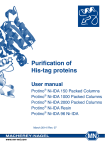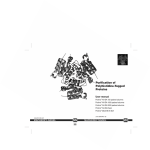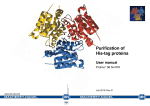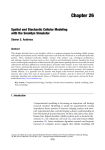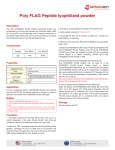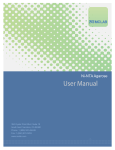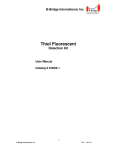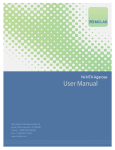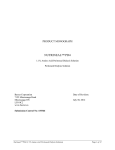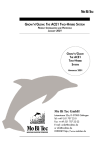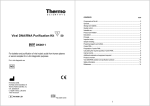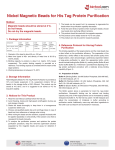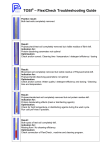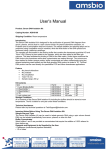Download MoBiTec Ni-IDA Columns for His-Tag Purification
Transcript
© MoBiTec GmbH 2015 Page 1 MoBiTec Ni-IDA Columns MoBiTec GmbH, Germany Phone: +49 551 70722 0 Fax: +49 551 70722 22 E-Mail: [email protected] www.mobitec.com © MoBiTec GmbH 2015 Page 2 Contents 1. Features......................................................................................................................3 2. Introduction................................................................................................................3 3. Product Contents ......................................................................................................4 3.1.Kit components ....................................................................................................... 4 3.2.Storage and expiry .................................................................................................. 4 3.3.Equipment and materials to be supplied by user .................................................... 4 3.4.Buffer compositions ................................................................................................ 4 4. Terms and Conditions ...............................................................................................5 5. Technical Information ...............................................................................................5 5.1. Protein binding ....................................................................................................... 5 5.2. Binding capacity ..................................................................................................... 6 5.3. Purification of secretory proteins ............................................................................ 6 5.4. Purification under native and denaturing conditions ............................................... 6 5.5. Culture size ............................................................................................................ 7 6. Protocols ....................................................................................................................7 6.1. Purification of secreted polyhistidine-tagged proteins from the supernatant ..........7 6.2. Purification of periplasmic polyhistidine-tagged proteins……………………………7 6.3. Purification of intracellular polyhistidine-tagged proteins under native or denaturing conditions…………………………………………………………….………8 6.4. Ni-IDA chromatography under native conditions……………………………………...9 6.5. Ni-IDA chromatography under denaturing conditions……………………………….10 6.6. Storage, Reuse and Regeneration ........................................................................ 10 6.7. Compatibility of reagents ....................................................................................... 12 6.8. Troubleshooting..................................................................................................... 13 7. Order Information, Shipping, and Storage ............................................................ 14 8. Contact and Support ............................................................................................... 14 MoBiTec GmbH, Germany Phone: +49 551 70722 0 Fax: +49 551 70722 22 E-Mail: [email protected] www.mobitec.com © MoBiTec GmbH 2015 Page 3 1. Features Excellent tool for routine purification of recombinant polyhistidine-tagged proteins - under native and denaturating conditions - starting from diverse expression systems, e.g., E. coli, yeast, insect and mammalian cells Maximal binding capacity: 90 mg protein per column Protein recovery rate > 80% Improved target specificity by optimized silica-based Ni2+-IDA matrix Imidazol free loading and washing buffer Columns are long-term storable when kept dry 2. Introduction MoBiTec Ni-IDA Columns with silica-based resin provide a fast and convenient routine tool for purification of recombinant polyhistidine-tagged proteins by gravity flow. The formstable silica matrix is precharged with Ni2+ ions and allows purification on the principle of Immobilized Metal Ion Affinity Chromatography (IMAC). Binding of proteins is based on the interaction between the polyhistidine tag of the recombinant protein and immobilized Ni2+ ions. The chelating group of the Ni-IDA resin is based on IDA (iminodiacetic acid), which enables strong and efficient binding of target protein onto the IMAC matrix. In contrast to traditional IDA matrices, MoBiTec Ni-IDA is an optimized matrix with low density of IDA ligands. This non-saturating surface concentration of IDA eliminates almost all non-specific interactions of contaminating host proteins with the adsorbent. As a result, MoBiTec Ni-IDA provides higher target protein purity. IDA is a tridentate chelator which occupies three of the six binding sites in the coordination sphere of the Ni2+ ion. The remaining three coordination sites are usually occupied by water molecules and can be exchanged with histidine residues of the recombinant protein (Fig. 1). Fig.1: Silica-based Ni-IDA matrix. Schematic drawing of IDA in complex with Ni2+. MoBiTec GmbH, Germany Phone: +49 551 70722 0 Fax: +49 551 70722 22 E-Mail: [email protected] www.mobitec.com © MoBiTec GmbH 2015 Page 4 3. Product Contents 3.1. Kit components Order# PR-HTK004 Product MoBiTec Ni-IDA Columns PR-HTK010 MoBiTec Ni-IDA Columns Components included 4 columns with matrix (dry), prepacked; user manual 10 columns with matrix (dry), prepacked; user manual 3.2. Storage and expiry MoBiTec Ni-IDA Columns are storable at room temperature for at least 1 year. 3.3. Equipment and materials to be supplied by user • Microliter pipettes • Appropriate centrifuge (≥ 10000 x g) and tubes for collection and centrifugation (size is depending on culture volume) • Sonicator • Lysozyme • Optional: Phenylmethylsulfonyl fluoride (PMSF) DNase I 0.45 µm membrane filter • 500 mM EDTA and 5 mM MgSO4 (only for preparation of periplasmic proteins) • Buffers according to protocol (composition of all buffers see 3.4.) 3.4. Buffer compositions Lysis-Equilibration-Wash Buffer (LEW Buffer) Required for the following protocol: “6.3.1. Preparation of cleared lysates under native conditions”, “6.3.2. Preparation of cleared lysates under denaturing conditions” • 50 mM NaH2PO4 • 300 mM NaCl • adjust pH to 8.0 using NaOH Elution Buffer Required for the following protocol: “6.3.1. Preparation of cleared lysates under native conditions” • 50 mM NaH2PO4 • 300 mM NaCl • 250 mM imidazole • adjust pH to 8.0 using NaOH Denaturing Solubilization Buffer Required for the following protocol: “6.3.2. Preparation of cleared lysates under denaturing conditions” Please prepare shortly before use! • 50 mM NaH2PO4 • 300 mM NaCl MoBiTec GmbH, Germany Phone: +49 551 70722 0 Fax: +49 551 70722 22 E-Mail: [email protected] www.mobitec.com © MoBiTec GmbH 2015 Page 5 • 8 M urea • adjust pH to 8.0 using NaOH Denaturing Elution Buffer Required for the following protocol: “6.3.2. Preparation of cleared lysates under denaturing conditions” Please prepare shortly before use! • 50 mM NaH2PO4 • 300 mM NaCl • 8 M urea • 250 mM imidazole • adjust to pH to 8.0 using NaOH Sucrose Buffer Required for the following protocol: “6.2. Purification of periplasmic polyhistidinetagged proteins” • 30 mM Tris/HCl • 20% sucrose Adjust pH to 8.0 4. Terms and Conditions For research use only. NOT recommended or intended for diagnosis of disease in humans or animals. Do NOT USE internally or externally in humans or animals. All chemicals should be considered as potentially hazardous. Only persons trained in laboratory techniques and familiar with the principles of good laboratory practice should handle these products. Suitable protective clothing such as laboratory overalls, safety glasses, and gloves should be worn. Care should be taken to avoid contact with skin or eyes; if contact should occur, wash immediately with water (See Material Safety Data Sheet(s)). Product warranty is limited to our liability to replacement of this product. All other warranties, expressed or implied, including but not limited to any implied warranties of merchantability or fitness for a particular purpose, are excluded and do not apply. We shall have no liability for any direct, indirect, consequential, or incidental damages arising out of the use, the results of use, or the inability to use this product. 5. Technical Information 5.1. Protein binding Proteins containing one or more polyhistidine affinity tags, located at either the amino or carboxyl terminus of the protein, can bind to the Ni-IDA matrix with very high affinity. Even when the tag is not completely accessible (e.g., under native conditions), it will bind as long as more than two histidine residues are available for interaction. In general: the smaller the number of accessible histidine residues, the weaker the binding. MoBiTec GmbH, Germany Phone: +49 551 70722 0 Fax: +49 551 70722 22 E-Mail: [email protected] www.mobitec.com © MoBiTec GmbH 2015 Page 6 5.2. Binding capacity The maximal binding capacity of MoBiTec Ni-IDA Columns is 90 mg recombinant protein as tested for histidine-tagged green fluorescent protein (6xHis-GFP, 32 kDa). The actual obtained yield is depending on the concentration of the histidine-tagged fusion protein and its overall amount in the loaded sample. For a maximal recovery (> 80%) we recommend loading up to 75 mg polyhistidine-tagged protein within 2-3 ml sample volume. To obtain a maximum yield (with lower recovery values) we recommend loading even higher amounts of polyhistidine-tagged protein (up to 100 mg). A high concentration and a high overall amount will result in the highest possible yield. 5.3. Purification of secretory proteins Producing proteins by secretion can be a great benefit in case of proper folding, disulfide bond formation, and for directing toxic proteins out of the cell. In addition, purification might be easier since the proteins can be purified directly from the corresponding compartment (periplasmic space or culture medium) showing a lower amount of total protein. Secretory proteins contain a signal peptide that addresses them for the export into the periplasmic space (e.g., E. coli) or into the culture medium (e.g., Bacillus spec.). Please consider that in case of secretory proteins the polyhistidine-tag must be located C-terminal of the protein. Otherwise, the tag will be cleaved of during signal peptide processing. 5.4. Purification under native and denaturing conditions The decision whether to purify polyhistidine-tagged proteins under native or denaturing conditions depends on diverse considerations: protein location and solubility, the accessibility of the polyhistidine-tag, and whether biological activity must be retained. Depending on the expression system and the host, the recombinant proteins will accumulate in the cytoplasm or will be secreted into the periplasmic space or out into the culture medium. Secreted protein is in most cases correctly folded and soluble. Intracellularly accumulated recombinant protein remains either in a soluble form or aggregates as insoluble misfolded protein in inclusion bodies. In case of soluble protein (purified from cytoplasm, periplasm, or supernatant) with good accessibility of the polyhistidine-tag, the purification can be done under native conditions (see protocol “6.3.1. Preparation of cleared lysates under native conditions”). Native conditions may also be used if co-purification of associated proteins is desired. In case of inclusion body formation the polyhistidine-tagged protein has to be extracted from cell pellet using urea as denaturant (see protocol “6.3.2. Preparation of cleared lysates under denaturing conditions”). Denaturing conditions can also be an option for improving the accessibility of the polyhistidine-tag. Tabel 1: How to find the proper purification conditions: please choose Native conditions if … Denaturing conditions if … protein is soluble protein aggregates (e.g., inclusion bodies) polyhistidine-tag is good accessible the polyhistidine-tag is hardly accessible co-purification of associated proteins is desired MoBiTec GmbH, Germany Phone: +49 551 70722 0 Fax: +49 551 70722 22 E-Mail: [email protected] www.mobitec.com © MoBiTec GmbH 2015 Page 7 5.5. Culture size The recommended culture size volume complies with the concentration of the polyhistidine-tagged protein in the culture. The latter typically varies from <10 mg/l up to 100 mg/l depending on cell density and expression level. Table 2: Culture size guide Expression Recommended level culture volume High (100 mg/l) Low ( 10 mg/l) 0.2-1 l 2-10 l Recommended pellet wet weight (E. coli) 0.8-4 g 8-40 g Estimated amount of polyhistidine-tagged protein in sample 20-100 mg 20-100 mg 6. Protocols 6.1. Purification of secreted polyhistidine-tagged proteins from the supernatant (e.g. B. subtilis) For preparation of secreted polyhistidine-tagged proteins, cells and supernatant will be separated by centrifugation (15 min, 4500 x g to 6000 x g, 4 °C). The clear supernatant can be directly subjected to MoBiTec Ni-IDA columns. Please follow the protocol “6.3.1. Preparation of cleared lysates under native conditions” 6.2. Purification of periplasmic polyhistidine-tagged proteins Periplasmic proteins can be separated from cytoplasmic proteins by osmotic shock preparation (see protocol below). The obtained osmotic shock fluid can then be subjected to MoBiTec Ni-IDA columns. ● Harvest the cells from expression culture by centrifugation (15 min, 4500 x g to 6000 x g, 4 °C). ● Resuspend cell pellet in Sucrose Buffer at 80 ml per gram wet weight. ● Keep the cells on ice and add 500 mM EDTA solution dropwise to 1 mM final concentration. ● Incubate the cells on ice for 5-10 min with gentle agitation. ● Centrifuge the cell suspension at 8000 x g for 20 min at 4 °C. ● Remove supernatant completely and resuspend the pellet in the same volume of icecold 5 mM MgSO4 solution. ● Shake or stir for 10 min in an ice bath. ● Centrifuge at 8000 x g for 20 min at 4 °C. ● Carefully transfer the supernatant (containing the periplasmic proteins) to a clean tube without disturbing the pellet. ● If the supernatant is not clear, centrifuge a second time or filter through a 0.45 µm membrane to avoid clogging of the Ni-IDA column with insoluble material. ● Dialyze the supernatant extensively against LEW buffer. ● Store supernatant on ice. ● Proceed with the protocol “6.3.1. Preparation of cleared lysates under native conditions”. MoBiTec GmbH, Germany Phone: +49 551 70722 0 Fax: +49 551 70722 22 E-Mail: [email protected] www.mobitec.com © MoBiTec GmbH 2015 Page 8 6.3. Purification of Intracellular polyhistidine-tagged proteins under native or denaturing conditions For purification of intracellular polyhistidine-tagged proteins under native conditions, a considerable portion of the protein should be present in a soluble form. If so, please follow the protocol “6.3.1. Preparation of cleared lysates under native conditions”. High levels of recombinant protein expression might lead to the formation of insoluble aggregates; in E. coli, these are known as inclusion bodies. During preparation of intracellular recombinant protein, cells are disrupted and cell pellets are separated from the soluble fraction by centrifugation. In contrast to soluble protein that remains in the supernatant, the inclusion bodies will sediment with the cell debris, and the polyhistidine-tagged protein has to be extracted from cell pellet using urea as denaturant. 8 M urea completely solubilizes the inclusion bodies and 6xHis-tagged proteins. Under these denaturing conditions, the 6xHis-tag on a protein will be fully exposed so that binding to the Ni-IDA matrix is enabled. If most of the 6xHis-tagged protein is localized within inclusion bodies, please follow the protocol “6.3.2. Preparation of cleared lysates under denaturing conditions”. 6.3.1. Preparation of cleared lysates under native conditions (E. coli) ● Prepare the LEW buffer (Lysis-Equilibration-Wash Buffer) and the Elution Buffer as described in “3.4. Buffer compositions”. ● Harvest the cells from expression culture by centrifugation (15 min, 4500 x g to 6000 x g, 4 °C). ● Remove supernatant and store pellet at -20 °C or proceed immediately. Please perform all steps on ice! ● Thoroughly resuspend the pellet in LEW buffer (1.25-5 mg polyhistidine-tagged protein/ 1 ml LEW, see also table 3 below), by pipetting up and down or vortexing until complete resuspension is reached (no cell aggregates visible anymore). Add lysozyme to a final concentration of 1 mg/ml and optional protease inhibitor (e.g., 0.1 mM PMSF final concentration). Stir the solution on ice for 30 min. ● Sonicate the suspension on ice according to the instructions provided by the manufacturer (e.g. 10 x 15 sec burst with 20 sec rest (amplitude of 20%). ● Carefully check samples appearance after sonication. If the lysate is still viscous from incomplete fragmentation of DNA, add 5 µg/ml DNase I and stir on ice for additional 15 min. ● Centrifuge the crude lysate at 10000 x g for 30 min at 4 °C to remove cellular debris. ● Carefully transfer the supernatant to a clean tube without disturbing the pellet. ● If the supernatant is not clear, centrifuge a second time or filter through a 0.45 µm membrane to avoid clogging of the Ni-IDA column with insoluble material. ● Store supernatant on ice. Proceed with chapter “6.4. Ni-IDA chromatography under native conditions”. Table 3: LEW buffer volume guide Expression Recommended level culture volume High (100 mg/l) 200 ml (minimum) 1 l (maximum) 2 l (minimum) Low (10 mg/l) 10 l (maximum) MoBiTec GmbH, Germany Phone: +49 551 70722 0 Recommended pellet wet weight 0.8 g (minimum) 4 g (maximum) 8 g (minimum) 40 g (maximum) Fax: +49 551 70722 22 Ratio pellet weight/LEW volume 1:5 1:5 1:2 1:2 E-Mail: [email protected] Volume of LEW for resuspension 4 ml 20 ml 16 ml 80 ml www.mobitec.com © MoBiTec GmbH 2015 Page 9 6.3.2. Preparation of cleared lysates under denaturing conditions (E. coli) High levels of expression of recombinant proteins in a variety of expression systems can lead to the formation of insoluble aggregates; in E. coli, these are known as inclusion bodies. Strong denaturants such as 8 M urea completely solubilize inclusion bodies and 6xHis-tagged proteins. Under these conditions, the 6xHis-tag on a protein will be fully exposed so that binding to the Ni-IDA matrix may be improved. For preparation of intracellular recombinant proteins, cells are disrupted and cell pellets are separated from the soluble fraction by centrifugation. Whereas inclusion bodies will sediment with the cell debris, soluble recombinant protein remains in the supernatant. Clear supernatant can be directly subjected to MoBiTec Ni-IDA Columns (follow the protocol “6.4. Ni-IDA chromatography under native conditions”). In case of inclusion body formation, the 6xHis-tagged protein has to be extracted from cell pellet using urea as denaturant (follow the protocol below). Isolation of inclusion bodies ● Harvest the cells from expression culture by centrifugation (15 min, 4500 x g to 6000 x g, 4 °C). ● Remove supernatant and store pellet at -20 °C or proceed immediately. Please perform all steps on ice! ● Thoroughly resuspend the pellet in LEW buffer (1.25-5 mg polyhistidine-tagged protein/1 ml LEW, see also table 3), by pipetting up and down or vortexing until complete resuspension is reached (no cell aggregates visible anymore). Add lysozyme to a final concentration of 1 mg/ml and optional protease inhibitor (e.g., 0.1 mM PMSF final concentration). Stir the solution on ice for 30 min. ● Sonicate the suspension on ice according to the instructions provided by the manufacturer (e.g., 10 x 15 sec burst with 20 sec rest (amplitude of 20%). ● Carefully check sample appearance after sonication. If the lysate is still viscous from incomplete fragmentation of DNA, add 5 µg/ml DNase I and stir on ice for additional 15 min. ● Centrifuge the crude lysate at 10000 x g for 30 min at 4 °C to collect inclusion bodies. Discard the supernatant and keep the pellet on ice. Solubilization of inclusion bodies ● Resuspend the pellet in 10 ml LEW buffer to wash the inclusion bodies. Centrifuge the suspension at 10000 x g for 30 min at 4° C and discard the supernatant. ● Resuspend the pellet in 2 ml “Denaturating Solubilization Buffer” to solubilize the inclusion bodies. For complete solubilization it may be necessary to vortex or sonicate the solution. Stir the suspension for further 60 min on ice. ● Centrifuge at 10000 x g for 30 min at 20 °C to remove any remaining insoluble material. Carefully transfer the supernatant to a clean tube without disturbing the pellet. ● If the supernatant is not clear, centrifuge a second time or filter through a 0.45 µm membrane to avoid clogging of the MoBiTec Ni-IDA column with insoluble material. ● Store supernatant at 4°C Proceed with chapter “6.5. Ni-IDA chromatography under denaturing conditions”. 6.4. Ni-IDA chromatography under native conditions Column equilibration Equilibrate the column with 8 ml LEW buffer. Allow the column to drain by gravity. MoBiTec GmbH, Germany Phone: +49 551 70722 0 Fax: +49 551 70722 22 E-Mail: [email protected] www.mobitec.com © MoBiTec GmbH 2015 Page 10 Binding Add the cleared lysate (at least 3 ml) to the pre-equilibrated column and allow the column to drain by gravity. Washing Wash the column three times with 8 ml LEW buffer (3 x 8 ml). Allow the column to drain by gravity. Elution Elute the polyhistidine-tagged protein in 3-6 fractions. Add in total 18 ml Elution Buffer divided in a suitable number of fractions and collect separately. Allow the column to drain by gravity. Note: Commonly, 90% of the eluted protein can be found within the first 6 ml of elution. Use protein assay and/or SDS-PAGE analysis to determine which fraction(s) contain(s) the majority of the polyhistidine-tagged protein. 6.5. Ni-IDA chromatography under denaturing conditions Column Equilibration Equilibrate the column with 8 ml of “Denaturing Solubilization Buffer”. Allow the column to drain by gravity. Binding Add the cleared lysate (at least 3 ml) to the pre-equilibrated column and allow the column to drain by gravity. Washing Wash the column twice with 16 ml “Denaturing Solubilization Buffer”. Allow the column to drain by gravity. Elution Elute the polyhistidine-tagged protein in 3-6 fractions. Add in total 18 ml “Denaturing Elution Buffer” divided in a suitable number of fractions and collect separately. Allow the column to drain by gravity. Note: Commonly, 90% of the eluted protein can be found within the first 6 ml of elution. Use protein assay and/or SDS-PAGE analysis to determine which fraction(s) contain(s) the majority of the polyhistidine-tagged protein. 6.6. Storage, reuse, and regeneration 6.6.1. Reuse and short-term storage Depending on the nature of the sample, MoBiTec Ni-IDA Columns can be reused 3-5 times. Reuse should only be performed with identical polyhistidine-tagged proteins to avoid possible cross-contamination. After the final elution step wash the column with the following solutions: 1. 10 ml 100 mM EDTA, pH 8 2. 10 ml deionized water 3. 10 ml 100 mM NiSO4 4. 10 ml deionized water 5. After equilibrating with LEW buffer or “Denaturing Solubilization Buffer” the column is ready for reuse. MoBiTec GmbH, Germany Phone: +49 551 70722 0 Fax: +49 551 70722 22 E-Mail: [email protected] www.mobitec.com © MoBiTec GmbH 2015 Page 11 6. For storage overnight we recommend to store the column with LEW buffer at 4 °C. Otherwise follow the protocol for long-term storage below. 6.6.2. Long-term storage After performing the “reuse protocol” wash column with 1. 20 ml LEW buffer 2. 20 ml deionized water 3. 4 ml 20% ethanol 4. Store column with 20% ethanol at 4 °C 5. After equilibrating with 20 ml LEW buffer the column is ready for reuse. 6.6.3. Complete regeneration If a complete regeneration is mandatory, wash the column with the following solutions: 1. 4 ml 6 M GuHCl, 0.2 M acetic acid 2. 10 ml deionized water 3. 6 ml 2% SDS 4. 10 ml deionized water 5. 10 ml 100% ethanol 6. 10 ml deionized water 7. 10 ml 100 mM EDTA, pH 8 8. 10 ml deionized water 9. 10 ml 100 mM NiSO4 10. 20 ml deionized water 11. After equilibrating with 20 ml LEW buffer the column is ready for reuse. MoBiTec GmbH, Germany Phone: +49 551 70722 0 Fax: +49 551 70722 22 E-Mail: [email protected] www.mobitec.com © MoBiTec GmbH 2015 Page 12 6.7. Compatibility of reagents Buffer components that chelate metal ions, such as EDTA and EGTA, should not be used, since they strip Ni2+ ions from the matrix. Do not use buffers with pH > 8.4, since silica dissolves in solutions of high pH. Reagent Effect -mercaptoethanol Prevents formation of disulfide bonds; can reduce Ni2+ ions at higher concentrations. DTT, DTE Can reduce Ni2+ ions at higher concentrations. EDTA Ethanol Coordinates with Ni2+ ions, causing a decrease in capacity at higher concentrations. Prevents hydrophobic interactions between proteins. Glutathione reduced Can reduce Ni2+ ions at higher concentrations. Glycerol Prevents hydrophobic interactions between proteins. GuHCl Solubilizes proteins. Imidazole Binds to immobilized Ni2+ ions and competes with the polyhistidine-tagged proteins SDS Interacts with Ni2+ ions, causing a decrease in capacity. Sodium chloride Prevents ionic interactions and therefore unspecific binding. Sodium phosphate Used in LEW and Elution Buffer in order to buffer the solutions at pH 8. Tris Triton, Tween Urea MoBiTec GmbH, Germany Comment Up to 50 mM in samples has been successfully used in some cases. Up to 10 mM in samples has been successfully used in some cases. Not recommended, but up to 1 mM in samples has been used successfully in some cases. Up to 20% can be used; ethanol may precipitate proteins, causing low flow rates and column clogging. Up to 30 mM in samples has been successfully used in some cases. Up to 50% can be used. Up to 6 M can be used. Imidazole should not be included in LEW buffer. Not recommended, but up to 0.5% in samples has been used successfully in some cases. up to 2 M can be used, at least 0.3 M should be used 50 mM is recommended. The pH of any buffer should be adjusted to 8, although in some cases a pH between 7 and 8 can be used. 2+ Coordinates with Ni ions, 10 mM may be used, sodium causing a decrease in phosphate buffer is capacity. recommended Removes background proteins. Up to 2% can be used. Solubilizes proteins. Use 8 M urea for purification under denaturing conditions. Phone: +49 551 70722 0 Fax: +49 551 70722 22 E-Mail: [email protected] www.mobitec.com © MoBiTec GmbH 2015 Page 13 6.8. Troubleshooting Problem Sample does not enter the column bed. Protein does not bind to the resin. Protein elutes with wash buffer. Protein does not elute from column. Contamination of other proteins within the eluate. MoBiTec GmbH, Germany Caused by Sample/lysate contains insoluble material. Suggestions If sample is not clear, use centrifugation of filtration (0.45 µm membrane) to avoid clogging of the column. Sample/lysate contains Lysate may remain viscous from genomic DNA. incomplete shearing of genomic DNA after sonication. Add 5 µg/ml DNase I and incubate on ice for 10 min. Vector construct is not Check if gene of interest and tag correct. has been cloned in frame. Binding conditions are Check composition of buffers and incorrect. verify pH 7-8. Ensure that there is no chelating or strong reducing reagent or imidazole present. Buffer compositions are Check composition of buffers and incorrect. verify pH 7-8. Ensure that there is no chelating or strong reducing reagent or imidazole present. Elution conditions are too Increase concentration of mild imidazole. Insufficient washing Use larger volumes for washing. Binding and washing Add small amounts of imidazole conditions are too mild. (1-10 mM). Take care that the imidazole concentration remains low enough to enable binding of the polyhistidine-tagged proteins. Contaminating proteins and Add up to 30 mM -mercaptothe polyhistidine-tagged ethanol to reduce disulfide bonds. protein are connected via disulfide bonds. Contaminating proteins are - Perform cell lysis at 4 °C. degradation products of - Include protease inhibitor. polyhistidine-tagged protein. Expression is too low; this - Increase expression level. leads to increased binding - Increase amount of culture of contaminating proteins. volume or cell pellet weight. Phone: +49 551 70722 0 Fax: +49 551 70722 22 E-Mail: [email protected] www.mobitec.com © MoBiTec GmbH 2015 Page 14 7. Order Information, Shipping, and Storage Order# PR-HTK004 PR-HTK010 Product MoBiTec Ni-IDA Columns MoBiTec Ni-IDA Columns Amount 4 columns 10 columns shipped at RT; store columns at RT 8. Contact and Support MoBiTec GmbH Lotzestrasse 22a D-37083 Goettingen Germany Customer Service – General inquiries & orders phone: +49 (0)551 707 22 0 fax: +49 (0)551 707 22 22 e-mail: [email protected] Technical Service – Product information phone: +49 (0)551 707 22 70 fax: +49 (0)551 707 22 77 e-mail: [email protected] MoBiTec in your area: Find your local distributor at www.mobitec.com MoBiTec GmbH, Germany Phone: +49 551 70722 0 Fax: +49 551 70722 22 E-Mail: [email protected] www.mobitec.com














